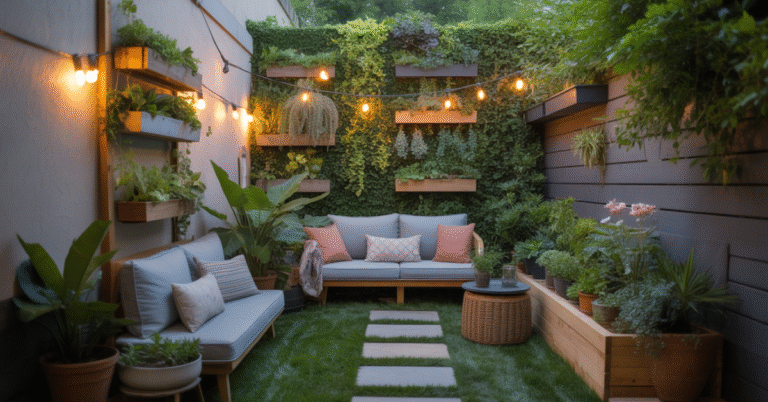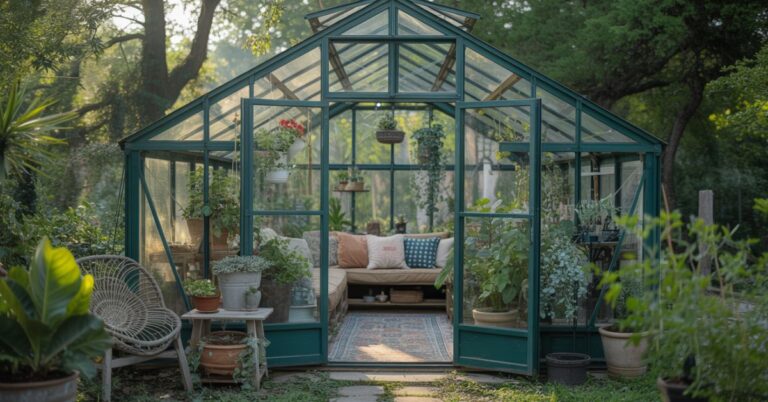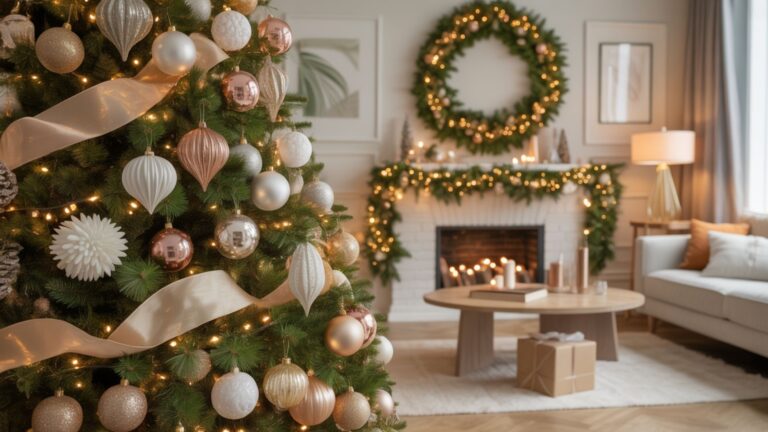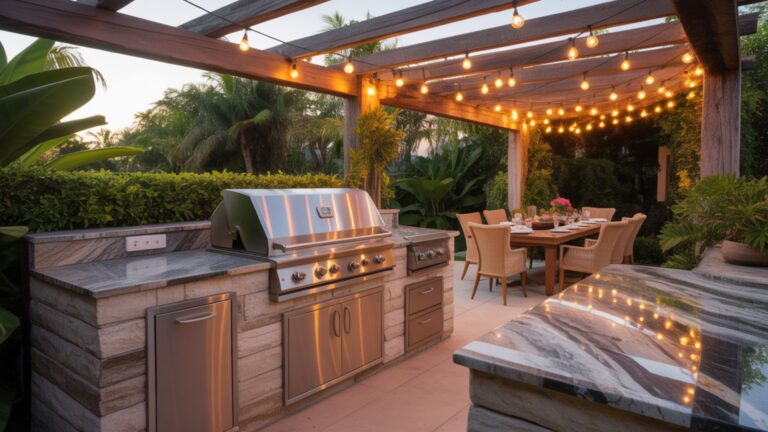37+ Outdoor Patio Ideas with Fireplace Ultimate Backyard Sanctuary
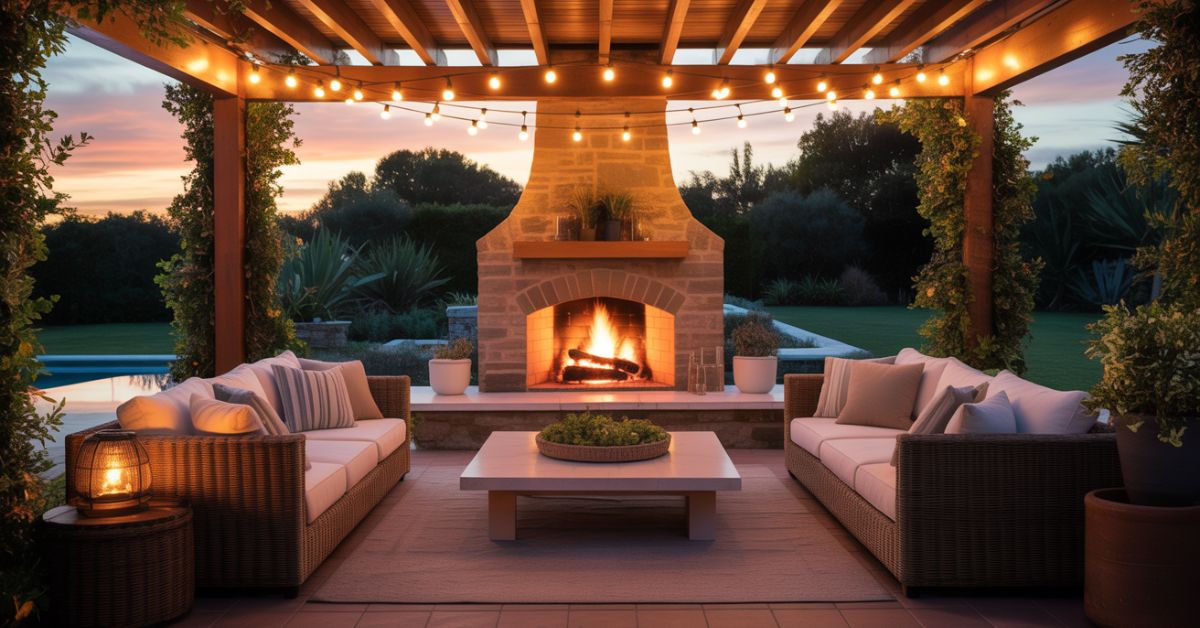
Your patio has potential, but something’s missing. You step outside and feel underwhelmed there’s no focal point, no reason to linger once the sun sets. Your outdoor space functions as a pass-through rather than a destination, and you know it could offer so much more.
The frustration builds when you see neighbors hosting evening gatherings around their glowing outdoor fireplace while your family stays inside. You’re missing countless opportunities for connection, conversation, and creating memories under the stars. Every cool evening that passes represents wasted potential for your outdoor investment.
The solution lies in strategic outdoor patio ideas with fireplace designs that transform ordinary spaces into magnetic gathering spots. A thoughtfully planned outdoor fireplace doesn’t just add warmth it creates architecture, establishes hierarchy, and provides the dramatic focal point your space desperately needs. This comprehensive guide reveals exactly how to design, build, and style an outdoor living room centered around a stunning fireplace that becomes your home’s most cherished feature.
Why Choose an Outdoor Fireplace Over a Fire Pit
Outdoor fireplaces deliver distinct advantages that fire pits simply cannot match. Understanding these differences shapes your entire patio fireplace layout strategy.
The vertical architecture of outdoor fireplace designs creates instant visual impact. Standing 8-12 feet tall, these structures command attention and establish clear focal points that organize surrounding spaces. Unlike fire pits that sit low and require close proximity, fireplaces provide warmth and ambiance visible from across your yard. This architectural presence adds property value substantially appraisers recognize permanent structures more readily than portable features.
What Are the Main Types of Outdoor Fireplaces
Outdoor fireplace designs fall into distinct categories, each offering specific benefits for your backyard fireplace ideas. Selecting the right type determines both aesthetics and functionality.
Masonry fireplaces represent the traditional gold standard. Brick or stone fireplace patio structures built from the ground up offer complete customization and unmatched permanence. Skilled masons create one-of-a-kind designs incorporating fireplace mantels, built-in seating, and storage compartments. These structures integrate seamlessly with existing architecture, matching your home’s brick, stone, or stucco perfectly. The investment runs $5,000-$15,000+ depending on size and materials, but the results deliver heirloom-quality craftsmanship that appreciates alongside your property.
Double-sided fireplaces serve multiple spaces simultaneously. These see-through designs separate distinct zones dining on one side, lounging on the other while providing shared warmth and ambiance. The transparent element creates architectural interest while maintaining visual connection between spaces. This sophisticated approach suits larger properties where multiple outdoor living zones exist.
Read More About: 27+ Outdoor Patio Ideas for Apartments
How Do You Choose Between Wood-Burning and Gas Outdoor Fireplaces
The wood vs gas decision impacts everything from installation costs to daily usability. Each fuel type creates different experiences worth understanding thoroughly.
Wood-burning fireplaces deliver authentic crackling sounds, distinctive aromas, and mesmerizing flame patterns that gas cannot replicate. The ritual of building fires, tending flames, and managing logs adds ceremonial elements many homeowners cherish. No utility connections are required, making them viable for remote patio fireplace layouts far from gas lines. Wood costs less than propane per BTU, though you’ll invest significant time sourcing, storing, and managing fuel supplies.
The downsides demand consideration. Wood-burning units require regular ash removal, annual chimney cleaning, and constant fire management. Smoke production bothers some guests despite chimney systems directing most away. Increasingly strict air quality regulations restrict wood burning in many municipalities, especially during high-pollution days. Starting fires takes 15-30 minutes versus instant ignition with gas alternatives.
What Size Outdoor Fireplace Do You Need for Your Patio
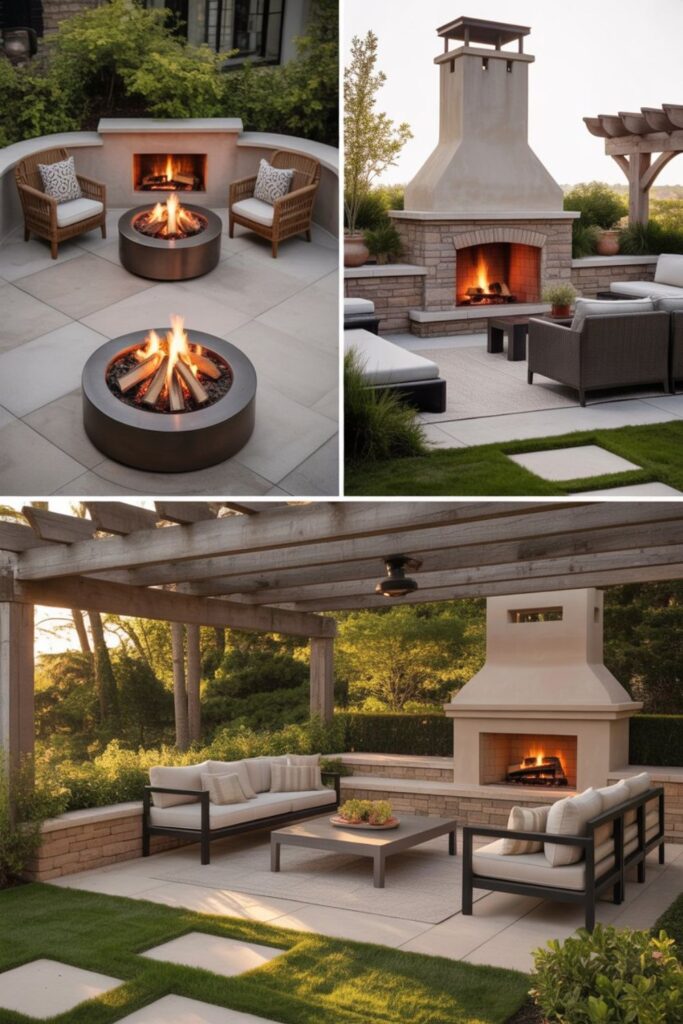
Fireplace dimensions directly impact both functionality and aesthetics. Proper scaling ensures your structure serves rather than overwhelms its space.
Standard outdoor fireplaces measure 4-6 feet wide with fireboxes 3-4 feet across. This sizing accommodates 8-12 people comfortably while providing adequate heat for seating zones extending 12-15 feet forward. Heights typically reach 8-10 feet including chimneys, establishing commanding presence without blocking second-story windows or views.
For intimate patios under 300 square feet, scale down to 3-4 foot widths. Oversized fireplaces dominate small spaces visually while producing excess heat that drives people away. Conversely, sprawling patios exceeding 600 square feet need 6-8 foot structures to maintain proportional impact. A tiny fireplace on a massive patio looks lost and inadequate, failing to anchor the design effectively.
Chimney height follows specific safety and draft requirements. Most codes mandate chimneys extend at least 2 feet above any roof point within 10 feet horizontally. Proper height ensures adequate draft for smoke evacuation and prevents downdrafts that blow smoke back into seating areas. Insufficient chimney height causes chronic smoking problems requiring expensive reconstruction.
Firebox depth matters significantly for heat projection. Shallow boxes (12-16 inches) reflect more heat forward, warming seating areas efficiently. Deeper fireboxes (20-24 inches) accommodate larger logs and produce longer burns but project less heat outward. Your climate and intended use patterns should guide this specification, colder regions benefit from deeper boxes supporting sustained fires.
How Should You Position Your Outdoor Fireplace on Your Patio
Strategic placement determines whether your outdoor fireplace becomes the heart of your patio or an awkward afterthought. These positioning principles ensure optimal functionality.
Corner locations maximize usable space. Positioning your fireplace in one corner leaves three sides open for furniture, traffic flow, and alternative uses. This arrangement works beautifully for rectangular patios where the fireplace anchors one end while dining or other activities occupy the opposite end. The perpendicular walls created by corner placement also provide wind protection from two directions.
Centered placements on long walls create symmetrical seating configurations that feel formal and intentional. This traditional approach suits properties where the fireplace backs to property lines, fences, or house walls. The centered position allows balanced furniture arrangements on either side, creating cohesive outdoor living room aesthetics. This works especially well when your patio serves as an extension of interior spaces the fireplace becomes a natural focal point visible from inside.
Freestanding fireplaces positioned away from structures offer 360-degree design opportunities. These statement pieces become sculptural elements visible from multiple vantage points. However, they require substantial footprints and work best on larger properties where the fireplace can float in space without impeding circulation. This avant-garde approach delivers maximum visual drama.
Wind patterns must inform placement decisions. Observe your patio during typical use times, noting prevailing winds. Position fireplaces so prevailing winds blow smoke away from primary seating areas. Installing outdoor fireplaces where wind consistently blows smoke into gathering zones creates unusable spaces despite significant investment.
Maintain proper clearances from combustible materials. Most codes require 10-25 feet between fireplaces and structures, overhanging trees, or property lines. These setbacks ensure safety and legal compliance violations force expensive relocations and create liability exposure.
What Materials Work Best for Outdoor Fireplace Construction
Material choices define your outdoor fireplace’s aesthetic, durability, and cost. The right selections align with architectural context while withstanding weather extremes.
Natural stone creates timeless elegance that ages beautifully. Fieldstone, limestone, or sandstone stone fireplace patio designs integrate organically with landscapes while providing exceptional longevity. Each stone’s unique coloring and texture ensures one-of-a-kind results. The irregular shapes create organic appearances well-suited to traditional and rustic styles. Expect $50-$100+ per square foot for premium natural stone materials and installation.
How Do You Arrange Seating Around an Outdoor Fireplace
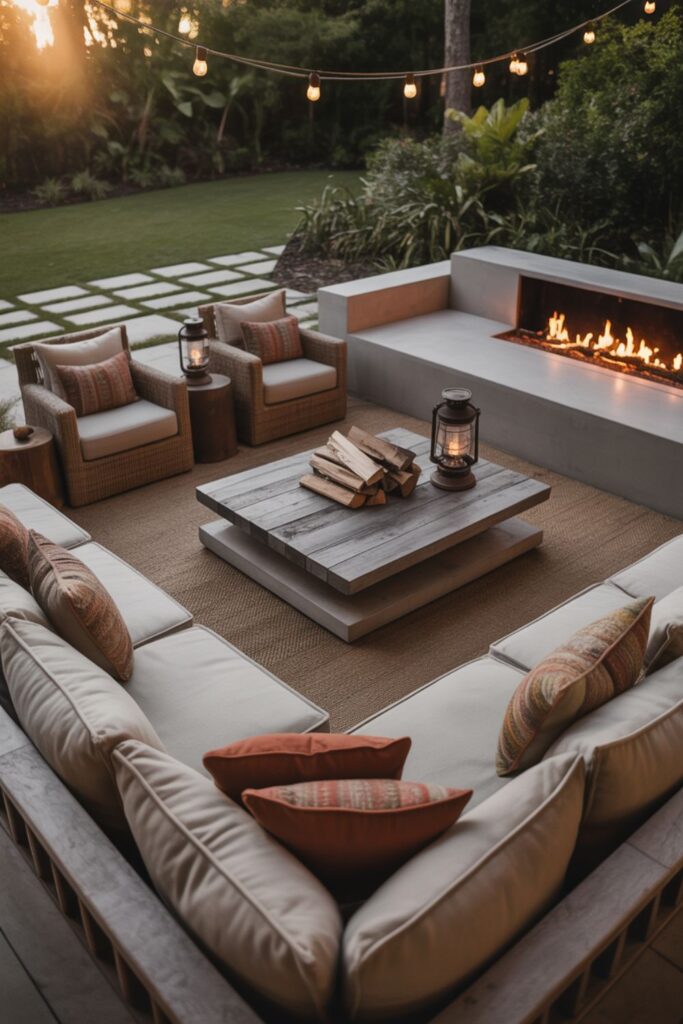
Seating configuration determines how effectively your outdoor fireplace serves as a gathering space. Strategic arrangements maximize both warmth and social interaction.
Semicircular arrangements facing the fireplace create intimate conversation zones. Position sofas, loveseats, or individual chairs in a 180-degree arc, 6-10 feet from the firebox. This distance balances warmth with comfortcloser feels too hot, farther losing heat benefits. The inward-facing orientation facilitates eye contact and conversation while everyone enjoys equal heat reflection from the structure.
L-shaped configurations suit corner fireplaces perfectly. Place one seating group perpendicular to the fireplace and another parallel, creating an L that wraps the corner. This arrangement accommodates larger groups while maintaining the intimate scale. The perpendicular section benefits from heat reflection off adjacent walls, creating particularly cozy spots.
Layered seating with multiple rows accommodates varying temperature preferences. Position heat-tolerant seating (metal or wicker chairs) closest to flames for those seeking maximum warmth. Place upholstered sofas or cushioned chairs in a secondary zone 12-15 feet back for guests preferring ambiance over intense heat. This graduated approach lets everyone find their comfort level.
Built-in stone benches flanking the fireplace maximize seating without consuming floor space. Extend low walls on either side of the firebox, topping them with heat-resistant materials and cushions. These permanent seats anchor your layout while movable chairs supplement as needed. The integrated approach creates cohesive outdoor living room aesthetics.
Include some perpendicular seating facing outward toward views. Not everyone wants constant fireplace focussome prefer watching sunsets, observing children playing, or admiring gardens. Mixed orientations accommodate diverse preferences, making your space more versatile.
What Are the Best Outdoor Fireplace Design Styles
Outdoor fireplace designs span architectural styles from traditional to ultra-modern. Selecting designs that harmonize with your home’s architecture ensures cohesive results.
Rustic fireplaces using fieldstone or river rock create organic focal points. Irregular stone shapes, earth-tone colors, and rough-hewn fireplace mantels complement log homes, craftsman architecture, or natural settings. These designs intentionally avoid perfect symmetry, celebrating material variations and artisan craftsmanship. The rugged aesthetic ages gracefully, developing patina that enhances rather than diminishes appearance.
Traditional fireplaces featuring brick or cut stone maintain classic proportions and symmetry. Arched firebox openings, formal mantels, and precise masonry patterns create refined appearances suited to colonial, Georgian, or Victorian homes. These designs often incorporate decorative details like corbels, keystones, or carved accents that reference historical precedents while remaining functional for contemporary use.
How Can You Incorporate Cooking Features into Outdoor Fireplaces
Multi-functional outdoor fireplace designs maximize value by serving culinary purposes. Strategic additions transform heating features into outdoor kitchens.
Built-in pizza ovens adjacent to fireplaces share infrastructure efficiently. Constructing both features from common walls and chimneys reduces material costs while creating cohesive appearances. The pizza oven’s dome shape and smaller opening distinguish it from the main firebox, creating visual interest. Wood-fired cooking adds authentic flavor while the fireplace maintains ambiance during meal preparation.
Swing-arm grills mounted inside fireboxes enable direct-flame cooking. Heavy-duty arms swing cooking grates over flames, providing adjustable heat control through positioning. This simple addition requires minimal modification to standard fireplace designs while delivering genuine wood-fired flavor. The open-flame cooking becomes entertainment, with guests watching meal preparation.
What Lighting Enhances Outdoor Fireplace Patios
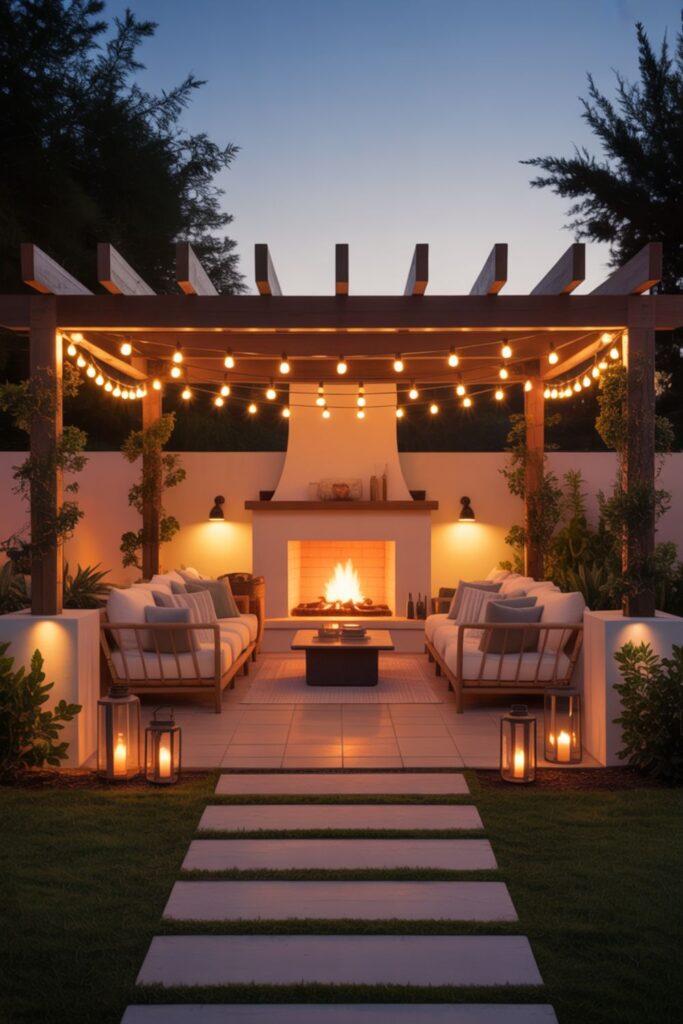
Strategic illumination extends usability while showcasing your outdoor fireplace’s architectural beauty. Layered lighting creates depth and ambiance beyond firelight alone.
Uplighting the chimney creates dramatic nighttime presence. Install LED fixtures at the fireplace base, angling beams upward along the structure. This technique emphasizes vertical lines while casting interesting shadows from stone texture or stacked stone patterns. The upward wash makes your fireplace visible from across the property, establishing clear focal points after dark.
Fireplace mantel lighting provides functional illumination for gathering zones. Install LED strip lights along the underside of mantels or countertops, creating indirect glow that illuminates seating areas without harsh glare. This practical lighting serves drinks, games, or conversations while maintaining an intimate atmosphere.
Path lighting guides guests safely to fireplace seating areas. Low-voltage fixtures spaced 6-8 feet apart along walkways prevent tripping hazards while establishing intentional circulation patterns. Choose fixtures complementing your outdoor fireplace design stylecontemporary, traditional, or rusticfor cohesive aesthetics.
String lights overhead supplement firelight during pre-fire hours. Hang weather-resistant bulbs across seating zones, providing ambient glow before the fireplace ignites. Once flames establish, dimming or extinguishing string lights lets fire become the primary light source, creating primal focus on the hearth.
Accent lighting highlights surrounding landscaping. Illuminate nearby trees, shrubs, or architectural features, creating layers of visual interest beyond the fireplace itself. This expanded lighting scheme makes your entire outdoor living room feel designed and intentional rather than focused on a single element.
Consider dimmable systems that adjust to changing conditions. Bright illumination suits pre-gathering setup and cleanup, while low levels maintain ambiance during peak enjoyment. Smart controls allow smartphone adjustments without leaving comfortable seating.
How Much Does an Outdoor Fireplace Cost to Build
Understanding financial commitments helps you plan realistic outdoor patio ideas with fireplace projects. Costs vary dramatically based on controllable decisions.
Prefabricated fireplace kits start around $2,000-$4,000 for basic models. These include fireboxes, chimneys, and basic surrounds requiring minimal finishing. Professional installation adds $1,000-$3,000 depending on site preparation needs and complexity. Total projects using prefabricated units typically run $3,000-$7,000, delivering functional outdoor fireplaces at entry-level investment.
Custom masonry fireplaces built on-site cost substantially more. Basic brick or stone designs start around $5,000-$8,000 for modest sizes using standard materials. Premium natural stone, larger dimensions, or complex designs push costs to $10,000-$20,000+. Elite projects incorporating pizza ovens, extensive built-in seating, or rare materials exceed $30,000. These investments deliver heirloom-quality structures that are appreciated alongside .
What Are Essential Safety Features for Outdoor Fireplaces
Safety measures protect people and property without diminishing enjoyment. These precautions transform outdoor fireplaces from liabilities to assets.
Proper chimney height ensures adequate draft and smoke evacuation. Codes typically mandate chimneys extend 2 feet above any structure within 10 feet horizontally. Insufficient height causes chronic smoking problems and dangerous downdrafts. Professional design ensures compliance while optimizing draft performance.
Spark arrestors cap chimneys, preventing ember escape. These mesh screens block large sparks while allowing smoke passage. This simple addition prevents roof fires and vegetation ignition, especially critical in dry climates or wooded properties. Install commercial-grade arrestors rated for your chimney size.
Firebox screens contain flying sparks. Glass doors or metal mesh screens prevent embers from escaping toward seating areas. Glass options provide wind protection while maintaining visibility. Screens should open easily for fire tending but remain closed during unattended burning.
Non-combustible hearth extensions prevent ground fires. Extend heat-resistant materials like stone, concrete, or pavers at least 16 inches in front of firebox openings. Side clearances should reach 8-12 inches minimum. These zones catch falling embers before they contact combustible materials.
Fire extinguishers mounted nearby provide emergency response capability. Install 5-10 pound ABC extinguishers within 30 feet of fireplaces, visible but not prominently displayed. Supplement with garden hoses or water sources accessible during emergencies.
Carbon monoxide concerns apply mainly to enclosed structures. Outdoor fireplaces with adequate clearances rarely create CO buildup. However, covered patios or three-season rooms require CO detectors if fireplaces operate while spaces are partially enclosed.
Establish clear combustible-free zones. Keep furniture, cushions, decorations, and firewood storage at least 3 feet from firebox openings. Mark boundaries through furniture placement or hardscaping so guests instinctively respect safety perimeters.
How Do You Maintain Your Outdoor Fireplace
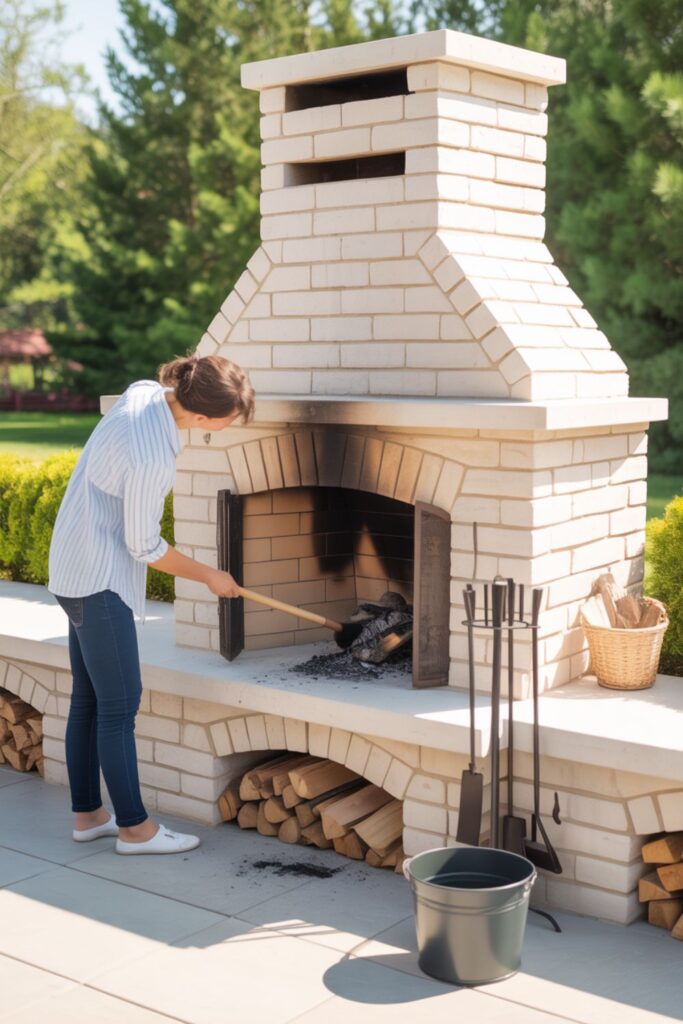
Regular maintenance preserves your investment and ensures safe operation. Required effort depends on fuel type and construction materials.
Wood-burning fireplaces require annual chimney cleaning. Creosote buildup creates fire hazards and restricts draft. Professional sweeps remove deposits while inspecting for damage. Schedule cleanings before heating seasons when availability is best. Costs run $150-$300 annually but prevent expensive repairs and dangerous situations.
Ash removal after each use maintains efficiency. Allow ashes to cool completely24 hours minimum before disposal. Store ashes in metal containers, never plastic, as hidden embers remain hot for days. Excessive ash accumulation restricts airflow and reduces heat output.
Gas fireplaces need annual burner inspections. Professional technicians verify proper ignition, check gas connections, and clean burner ports. Spider webs and debris commonly block ports, affecting flame patterns. Annual service costs $100-$200 but prevents gas leaks and ensures reliable operation.
Masonry and stone require periodic cleaning. Power wash exteriors annually, removing soot and weather staining. Inspect mortar joints for cracks or deterioration, addressing issues promptly. Repointing damaged mortar prevents water infiltration that causes freeze-thaw damage.
Stucco finishes need resealing every 3-5 years. Apply breathable sealers that prevent water penetration while allowing moisture vapor escape. This maintenance prevents cracking and extends finish life significantly in harsh climates.
Inspect chimney caps and spark arrestors seasonally. Replacing damaged screens immediately torn mesh defeats their protective purpose. Verify caps remain securely attached and flashing maintains weathertight seals.
Check structural integrity annually. Look for settling, cracking, or loose stone/brick. Address structural issues immediately before they worsen. Small cracks often signal foundation problems requiring professional evaluation.
Cover fireplaces during extended non-use periods. Quality covers prevent water accumulation, animal nesting, and debris collection. This simple protection extends lifespan dramatically, especially in harsh winter climates.
Read More About: Outdoor Patio Ideas with Pool Design a Luxurious Backyard Oasis
What Permits and Building Codes Apply to Outdoor Fireplaces
Navigating regulations prevents expensive problems. Outdoor fireplace requirements vary significantly by location, making thorough research essential.
Most jurisdictions require building permits for permanent outdoor fireplaces. Applications need detailed plans showing dimensions, materials, clearances, and chimney heights. Submit site plans indicating distances from property lines, structures, and overhead obstructions. Permit fees range $100-$800 depending on project size and location.
Setback requirements dictate placement. Most codes mandate fireplaces remain 10-25 feet from property lines and structures. Some municipalities impose greater distances for wood-burning units versus gas fireplaces. Document measurements carefully/violations require expensive relocations.
Chimney height regulations ensure safety and proper draft. Codes typically require chimneys extend 2-3 feet above any roof point within 10 horizontal feet. Local amendments sometimes increase these requirements. Professional design ensures compliance during planning rather than discovering issues during inspection.
Gas line installations require separate permits and licensed contractor work. Unlicensed gas work creates serious liability and violates most codes. Municipal inspectors verify proper sizing, connections, and pressure testing before approving installations.
Homeowner association restrictions often exceed municipal codes. Review CC&Rs thoroughly before planning some communities prohibit outdoor fireplaces entirely or limit specific fuel types. Violations can require removal at your expense plus potential fines.
Air quality regulations increasingly restrict wood-burning. Many regions ban burning during high-pollution alerts or specific seasons. Some jurisdictions prohibit new wood-burning fireplace installations entirely. Research local air quality rules before committing to fuel types.
Insurance implications deserve attention. Notify carriers about outdoor fireplace installations. Some policies require coverage riders while others exclude fire-related damage. Clarifying this before construction prevents devastating coverage gaps discovered too late.
Frequently Asked Questions
How far should an outdoor fireplace be from a house?
Most building codes require outdoor fireplaces to sit at least 10-15 feet from structures, though many jurisdictions mandate 20-25 feet for wood-burning units. Verify your local requirements before finalizing placement, as violations create liability exposure and force expensive relocations.
What is better for an outdoor fireplace, gas or wood? Gas outdoor fireplaces offer superior convenience with instant ignition, precise temperature control, no ash cleanup, and minimal maintenance requirements. Wood-burning units deliver authentic crackling sounds, distinctive aromas, and traditional ambiance that gas cannot fully replicate.
How much does it cost to add an outdoor fireplace to a patio? Prefabricated outdoor fireplaces installed professionally cost $3,000-$7,000 for complete projects including materials, labor, and basic site preparation..
Do outdoor fireplaces need chimneys? Yes, outdoor fireplaces require chimneys to direct smoke away from seating areas and ensure proper draft for combustion. Chimney height must meet building codes, typically extending 2 feet above any structure within 10 feet horizontally.
Can you use an outdoor fireplace year-round?
Outdoor fireplaces function year-round in most climates, though extreme weather may limit comfortable use. Quality construction withstands freeze-thaw cycles, moisture exposure, and temperature extremes without damage.
Conclusion
Your outdoor patio ideas with a fireplace represent transformative investments that redefine how you use your property. Strategic outdoor fireplace placement creates architectural focal points that organize spaces while providing warmth, ambiance, and gathering magnetism. From selecting between wood vs gas to choosing complementary natural stone or stacked stone materials, every decision shapes your outdoor living room’s character and functionality. The right patio fireplace layout balances aesthetics with practical considerations like heat reflection, seating configuration, and safety clearances.
Start by evaluating your specific needs, architectural context, and budget constraints. Research local codes and permit requirements before purchasing materials or beginning construction. Whether you install a prefabricated unit for quick results or commission custom masonry for heirloom quality, proper planning prevents costly mistakes. Your outdoor fireplace should feel like a natural extension of your home, pulling family and friends outside whenever weather permits. Take action now to design the backyard fireplace you’ve been envisioning. The memories created around those dancing flames will justify every dollar and hour invested in this remarkable outdoor feature.

